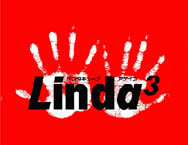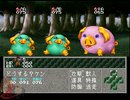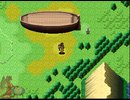|
|

|
PLATFORM
|
PSX
|
BATTLE SYSTEM
|

|
INTERACTION
|

|
ORIGINALITY
|

|
STORY
|

|
MUSIC & SOUND
|

|
VISUALS
|

|
CHALLENGE
|
Moderate
|
LANGUAGE BARRIER
|
Very High
|
COMPLETION TIME
|
40-60 Hours
|
|
OVERALL

|
+ Story is interesting and bizarre...
- ... just a little on the light side.
+ Terrific voice acting.
+ Great atmosphere.
- Cut-scenes are a little WTF at times.
+ Great for those who like exploration.
|
Click here for scoring definitions
|
|
|
I've been playing a lot of PlayStation titles this year. Some have been good, some have been awful. After putting down one that was fairly mediocre, I decided I needed a game that was fresh and bizarre. One game in my pile had that reputation, and it was called Linda3. Note that the 3 is an exponent, not a numeral. There is no Linda 1, nor is there a Linda 2. The name of the game is actually Linda Cube, though my PSX version of it has the word Again tacked on. So was it fresh and bizarre, like its reputation claimed?
Yes it was — and how.
The game puts forth its base situation in the opening credits. Neo Kenya is a doomed world. In just eight years it will have a fatal rendezvous with an asteroid called the Grim Reaper. While the colonists evacuate in an orderly fashion, the elder of the native Beastian church prays for the deliverance of Neo Kenya's animal life.
His prayers are answered. Out of nowhere appears an Ark, a sophisticated space menagerie which strongly resembles the Biblical craft. With it comes a monolith bearing instructions. Two of every Beast of the land must be brought unto the Ark, and two crew members shall be chosen to direct it to a new Eden. Those two are Ken Challenger, the protagonist, and his childhood friend Linda (the game's namesake).
Right about this point is where things start to get weird, as the player is presented with three scenarios. In Scenario A, Ken's girlfriend Linda is attacked, rendered amnesiac, and abducted by his evil twin, who was apparently raised by Santa-worshippers. In Scenario B, Ken and his fiancée Linda are attacked by bug-like assassin clones on their wedding night, and Linda loses her left arm. She gets a hefty replacement from a doctor who shares grooming tips with Hitler. In Scenario C, Ken awakens from a banana-induced coma to find that he and Linda are already married.
Obviously, these are not compatible situations. Linda3 lives up to its exponent by providing three alternate timelines, each with its own quirks. The first two scenarios possess the bulk of the game's story, while the third goes out of its way to reference, parody, and make inside jokes about the previous plots — like having the Evil Santa Twin fall in love with Clone Assassin Girl as one of its few major plot points. Whichever scenario is played, there is a marked lack of momentum in the storytelling. The usual pattern is: Story Event, wait one or two seasons and/or get to a certain level, get a message on Ken's ansaphone service that leads to another event, repeat. The goings-on are always quite interesting in themselves, but the story has been cut lean, without any extraneous material to fill in between plot points. Instead, there's exploration.
 This little piggy went to market...
This little piggy went to market...
|
|
And Scenario C is by far the most open in terms of exploration. A and B are limited in that various areas have been quarantined, irradiated, or are otherwise inaccessible. C provides three continents and a vast underground Eden full of strange species, and much of it is open to the player from the very beginning. Linda3 puts a premium on delving into the unknown. There are more than two dozen caves and ruins to explore, ranging from tiny little grottoes to massive complexes of tunnels that would be impossible to get through without the help of Ken's handy navigation tool. Levels and equipment are the only real limitations for where the player may go for much of the game, with only the Under Eden requiring special conditions for access.
No matter the scenario, the Grim Reaper hangs over the world. There is an effective time limit of eight years (or thirty-two seasons) to the game, though the first two scenarios can easily be completed in half that time. The third one is a bit harder, as it will require a lot of knowledge of the game's inner workings, locations, and seasonal quirks in order to find enough species to pass it. As spring turns to summer, autumn, and winter, different species may appear, or different genders may become more common. Eggs may only be acquired in the spring, and fruits in the summer. Lowland areas flood during the rainy seasons, while the northern regions freeze over. Finally, as time progresses in the game, the planet visibly depopulates. NPCs vanish from towns, taking with them various services. Entire towns become abandoned. It really does start to feel like the end of the world.
Linda3 presents on odd disparity in graphics. On the one hand, the animated sequences are top-notch and easily number among the best, if most violent and bizarre (spoilers, for any who care), seen on the PlayStation. On the other hand, while the graphics are a definite improvement over the original version, the fact remains that they're adapted from a TurboGrafx-16 title. Beasts are suitably colorful, bizarre, and/or disgustingly grotesque in battle, but the spritework outside of battle fails to impress. There may have been SNES titles that were technically superior in this area. Still, the level of detail shown in the game's locales is nothing short of amazing. It's easy to imagine Neo-Kenya as an actual world, even if the humans in it all look about the same. This level of detail extends to the player's options in town. There are more sorts of stores and services available than can be easily counted. In addition to the RPG staples, there are black markets, furniture stores, a well-implemented banking system, an incubator service, a vivisectionist, trappers, bounty-hunters, cage matches, dog-fighting, and a veterinary service.
 The Boss discusses Linda's good points.
The Boss discusses Linda's good points.
|
|
This last is important, as trained dogs make up half the player's party. Aside from Ken and Linda, there are only two other (temporary) playable characters. Dogs may be bought from the pound, and at higher levels Linda develops the ability to train various animals (including wolves, dolphins, and elephants) to do battle. Each variety of animal has a skillset, and individuals will randomly learn one skill from it every few levels.
Battles in Linda3 vaguely resemble those in the early Phantasy Star games, though without the more detailed character sprites in battle used by that series. Beasts and other enemies dominate the screen. The battlefield is composed of five squares, with the party in the center square, and the enemy in one or more of the surrounding areas. Each square has its own terrain type that is determined by the exact location the battle was initiated (by running into a Beast sprite on the map). Terrain mainly determines the speed with which a character or Beast may act, which in turn determines how many hits they can get in before the other side has a chance to react. For example, aquatic enemies are slow on most terrain, but can be devastatingly fast when encountered over water. Since the enemy may attack from any of four directions, it is sometimes necessary to take into account which direction a character is facing. Attacks from the side or from behind have a chance to hit harder, but it rarely becomes an issue of life or death.
Linda has the easiest time if knocked out in battle; she recovers with one hit point afterwards. Dogs and other trained animals need professional attention if they're K.O.'ed, with the prices varying considerably depending on the doctor's random diagnosis. If Ken is knocked out, however, the battle is lost. Everyone is returned to HQ, and there's a chance of losing some or all of the Beasts that the party has captured. Getting new Beasts to add to the Ark is the entire point of the game, and each scenario has a set quota to fulfill (30, 50, and 100, respectively). Some Beasts are quite rare, and others are just difficult to catch, so an untimely wipeout can be frustrating, or even hurt the player's chances for success in the end.
Beasts can only be captured if their hit points are brought down to a certain level, at which time capture is automatic. This tends to be within a range of 10% to -150% of the Beast's total HP, so thankfully it's possible to overkill something and still catch it. If a Beast takes too much damage in one hit, however, it will be rendered useless and won't even give experience points. Battles late in the game or with low-HP enemies force the player to consider alternatives if the goal is to bring the target back alive, which is a nice change of pace from simply bashing everything as hard as possible.
Ken and Linda can do a variety of things with the Beasts they collect. One male and one female of each species must be registered in the Ark, providing stat bonuses, new abilities, and beast forms for the two crew members. Beast forms can be assumed in battle to give stat boosts or terrain advantage, but abilities can be used regardless of form. Ken may also release Beasts during battle to attack enemies. Outside of battle, Beasts provide weapons, armor, and meat for various uses (food, healing, bait, or poisoning an enemy). At first, the services of a professional in town are needed to render animal parts, but Ken and Linda eventually gain the skills for themselves when they set up camp.
 The space zoo awaits.
The space zoo awaits.
|
|
Like the graphics, the music of Linda3 speaks strongly of its origins as a TurboGrafx-16 title. The soundtrack is mostly location themes, plus a single battle theme that only changes for the final boss fights for each scenario. It's interesting to note that in the first half of the Scenario A final battle, the fight music is shared with one of the towns of the game, and is recognizable as "Jingle Bells". For the most part, the music is intended to create a backdrop and a mood more than support specific scenes. A lot of synthesizer and sampled animal sounds are scattered throughout the audio. Fans of the 16-bit era of game music would probably enjoy it. All the animated sequences, most of the ansaphone messages, and a good portion of the non-animated major scenes are also voice-acted. Various roles required a lot of flexibility on the part of the actors, as some characters might be happy and helpful in one scenario, and psychotic in another. In particular, Minami Takayama shines as Linda in all her emotional states, and even sings at the end as the credits roll.
Despite the lean storyline, straightforward combat, and large-size Japanese font, Linda3 is hardly the most import-friendly of titles. Game menus are usually pretty well organized, but they might use kanji that are not normally seen in that context, and many shops offer services so outre (for the genre) that a read through the shopkeeper's helpful explanation text is often necessary. Important details are embedded in the animated sequences, but a lack of subtitles means that the player had better have a good ear for Japanese, or access to a handy FAQ (preferably both). While technically not much Japanese skill is needed to actually play the game, this will not help assuage the strong feeling that the player has no idea just what the hell is going on in the current scene. Of especial importance in Scenario C is that there is often a lot of information embedded in random NPC chatter that will help guide the player to new and hard-to-find species.
While Alfa System is known in the West, that's usually in regards to its for-hire work involving other companies' IPs. Linda3 stands as a testament to what this group can do if given free rein to exercise its imagination and ingenuity. It is also a strong indication of why Alfa System has not been allowed to do this in over a decade. Between the animation and the spritework, the battles and the support systems — not to mention the story, the story, and the lack-of-story — the game itself feels a bit schizophrenic at times. There is absolutely no reason for me to have enjoyed it as much as I have, much less to have essentially played through it three times in as many weeks. This is the sort of game which few would dare to make nowadays, and yet it thrives on this.
Review Archives
|









